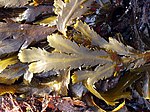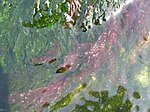Ocean's Embrace
The intricate world of macroalgae, from their vital ecological roles to their burgeoning potential in a changing climate.
Discover Seaweed 👇 Explore Uses 🌟Dive in with Flashcard Learning!
🎮 Play the Wiki2Web Clarity Challenge Game🎮
What is Seaweed?
Defining Macroalgae
Seaweed, or macroalgae, encompasses thousands of species of macroscopic, multicellular marine algae. This informal group includes species from the Rhodophyta (red), Phaeophyta (brown), and Chlorophyta (green) phyla. While often associated with algae, the term can also encompass submerged flowering plants like seagrasses, though these have a distinct evolutionary origin.
Ecological Significance
Seaweed ecosystems are fundamental to marine life, providing essential nursery habitats for numerous fisheries and other marine species. Furthermore, planktonic algae, often grouped with seaweed in broader ecological discussions, play a critical role in global biogeochemical cycles, producing at least half of the Earth's oxygen and significantly contributing to carbon capture through processes like biosequestration.
Threats and Cultivation
Natural seaweed habitats face threats from human activities such as mechanical dredging, which can destroy resources and dependent ecosystems. Ecological imbalances, like the surge in sea urchin populations due to the decline of their predators, can decimate kelp forests. In response, seaweed farming has emerged as a sustainable practice, offering food, chemical feedstocks, and potential climate change mitigation strategies.
Taxonomy and Diversity
Classification Overview
The term "seaweed" lacks a strict botanical definition but generally refers to macroscopic algae found in marine or brackish waters. While primarily encompassing red, green, and brown algae, the classification can sometimes include blue-green algae (Cyanobacteria). Notably, these groups do not share a single common multicellular ancestor, forming a polyphyletic assemblage. Scientists estimate there are several thousand distinct species of seaweed globally.
Example Genera
The diversity of seaweed is vast, with numerous genera adapted to various marine environments. The following table highlights a selection of these genera, illustrating their classification and typical habitats:
| Genus | Example Image | Algae Phylum | Remarks |
|---|---|---|---|
| Caulerpa |  |
Green | Submerged. |
| Fucus |  |
Brown | In intertidal zones on rocky shores. |
| Gracilaria |  |
Red | Cultivated for food. |
| Laminaria |  |
Brown | Also known as kelp, found 8–30 m underwater and cultivated for food. |
| Macrocystis |  |
Brown | Giant kelp forming floating canopies. |
| Monostroma |  |
Green | - |
| Porphyra |  |
Red | Intertidal zones in temperate climates; cultivated for food. |
| Sargassum |  |
Brown | Pelagic, especially in the Sargasso Sea. |
Anatomy of Seaweed
Structural Components
Seaweed exhibits an anatomy that, while resembling terrestrial plants, is adapted for an aquatic existence. Key structures include:
- Thallus: The entire body of the alga.
- Lamina (or Blade): A flattened, leaf-like structure, which may bear specialized reproductive structures called sori.
- Pneumatocyst: Gas-filled bladders that aid in flotation, keeping the lamina near the surface for optimal light exposure. Kelp species may have a specific float structure between the lamina and stipe.
- Stipe: A stem-like structure, which can be absent in some species, connecting the lamina to the holdfast.
- Holdfast: The basal anchoring structure, which can consist of simple extensions or complex finger-like projections called haptera, securing the seaweed to a benthic substrate.
The stipe and lamina together are often referred to as the frond.
Ecological Roles
Habitat and Function
Seaweed thrives in environments with seawater and sufficient light for photosynthesis. Most species require a substrate for attachment, commonly found in littoral zones and rocky shores. However, some genera, like Sargassum and Gracilaria, exist as free-floating organisms. Seaweed adapted to tidal rock pools must tolerate rapid changes in temperature and salinity, and occasional desiccation.
Carbon Sequestration
Seaweed plays a significant role in the global carbon cycle. Through photosynthesis, it absorbs atmospheric carbon dioxide. When seaweed fronds, particularly those from kelp forests, detach and drift into the deep ocean, they can sequester carbon on the seabed, contributing to "blue carbon" storage. This process is an active area of research for climate change mitigation strategies.
Food Web Contribution
Shedding of older fronds makes macroalgae a vital food source for benthic organisms, especially in intertidal zones. Detached fronds transported offshore also provide sustenance for deep-sea benthic communities, demonstrating seaweed's pervasive influence throughout marine food webs.
Global Production and Farming
Scale of Cultivation
The global seaweed production is substantial, with over 35 million tonnes harvested annually as of recent estimates. Asian countries dominate this sector, accounting for over 97% of the total. China and Indonesia are the leading producers, followed by South Korea and the Philippines. Seaweed farming is increasingly recognized for its economic benefits and its role in reducing pressure on wild fisheries.
Farming Practices
Seaweed farming ranges from simple harvesting of natural beds to sophisticated cultivation systems that manage the entire life cycle of specific species. Key farmed taxa include Eucheuma, Kappaphycus alvarezii (for carrageenan), Gracilaria (for agar), and species like Saccharina japonica and Undaria pinnatifida, which are primarily consumed as food. This practice is often implemented to improve local economies and promote sustainable resource management.
Production Statistics
The following table illustrates the significant contribution of various countries to global seaweed production:
| Country | Cultured and Wild Production |
|---|---|
| China | 20,351,442 |
| Indonesia | 9,962,900 |
| South Korea | 1,821,475 |
| Philippines | 1,500,326 |
| North Korea | 603,000 |
| Chile | 427,508 |
| Japan | 412,300 |
| Malaysia | 188,110 |
| Norway | 163,197 |
| United Republic of Tanzania | 106,069 |
Diverse Applications
Culinary and Food Industry
Seaweed is a staple food in many cultures, particularly across East and Southeast Asia. It is consumed directly or processed into forms like nori, wakame, and kombu. Its extracts, known as hydrocolloids (alginate, agar, carrageenan), are vital food additives, providing gelling, emulsifying, and water-retention properties used in confectionery, dairy products, sauces, and processed foods.
Medicinal and Biomedical Uses
Beyond nutrition, seaweed possesses significant medicinal and biomedical applications. Alginates are utilized in wound dressings and dental impressions. Agar serves as a crucial medium in microbiology for culturing microorganisms. Various seaweed polysaccharides exhibit potential antiviral properties and are explored for their roles in drug delivery and tissue engineering. Certain compounds may also aid in weight management.
Industrial and Environmental Applications
Seaweed finds utility in diverse industrial sectors. Its extracts are used in paper coatings, adhesives, dyes, and even explosives. Seaweed pulp can be processed into paper and bio-yarn for textiles. Environmentally, seaweed cultivation is recognized as a carbon-negative practice with potential for climate change mitigation, nutrient pollution reduction, and habitat restoration. It is also explored as a source for biofuels and as a sustainable additive to livestock feed to reduce methane emissions.
Health Considerations
Potential Hazards
While generally beneficial, seaweed consumption and interaction carry potential risks. The decomposition of large quantities of seaweed can release hydrogen sulfide, a highly toxic gas implicated in poisoning incidents. Additionally, certain species, such as the filamentous cyanobacterium Microcoleus lyngbyaceus (commonly known as "stinging seaweed"), contain toxins like lyngbyatoxin-a and debromoaplysiatoxin, which can cause severe skin irritation (seaweed dermatitis) upon contact.
Nutritional Balance
Seaweed can be a source of essential minerals and vitamins, but its nutritional profile requires careful consideration. While some components, like iodine, are beneficial in moderation, excessive intake can be problematic. Furthermore, seaweed can accumulate heavy metals from its environment, and its protein content is generally lower compared to terrestrial crops, necessitating a balanced dietary approach.
Ecological Threats
Environmental Challenges
Seaweed ecosystems face significant environmental pressures. Bacterial diseases, such as "ice-ice," can devastate commercially important species like Kappaphycus, leading to widespread crop losses. On a broader ecological scale, the proliferation of sea urchins, often unchecked by natural predators, can transform vibrant kelp forests into barren underwater landscapes, fundamentally altering marine habitats and impacting associated biodiversity.
Visualizing Seaweed's Impact
Culinary Traditions
Seaweed is integral to global cuisine, particularly in Japan and Korea, where it is prepared as nori for sushi and onigiri, and as wakame in miso soup. This highlights its cultural and nutritional significance in diverse culinary landscapes.
Regional Delicacies
In Wales, seaweed is transformed into laverbread, often prepared with oat flour. Similarly, in Belize, a sweet seaweed beverage is prepared with milk and spices, showcasing the varied ways this marine resource is incorporated into regional diets.
Sustainable Cultivation
The practice of seaweed farming is vital for economic development in coastal communities, as exemplified by the small plots cultivated by families in Indonesia. These farms provide essential resources while promoting sustainable aquaculture practices.
Teacher's Corner
Edit and Print this course in the Wiki2Web Teacher Studio

Click here to open the "Seaweed" Wiki2Web Studio curriculum kit
Use the free Wiki2web Studio to generate printable flashcards, worksheets, exams, and export your materials as a web page or an interactive game.
True or False?
Test Your Knowledge!
Gamer's Corner
Are you ready for the Wiki2Web Clarity Challenge?

Unlock the mystery image and prove your knowledge by earning trophies. This simple game is addictively fun and is a great way to learn!
Play now
References
References
- Global seaweeds and microalgae production(FAO)
Feedback & Support
To report an issue with this page, or to find out ways to support the mission, please click here.
Disclaimer
Important Notice
This page was generated by an Artificial Intelligence and is intended for informational and educational purposes only. The content is based on a snapshot of publicly available data from Wikipedia and may not be entirely accurate, complete, or up-to-date.
This is not professional advice. The information provided on this website is not a substitute for professional consultation regarding marine biology, aquaculture, environmental science, or food safety. Always refer to official documentation and consult with qualified professionals for specific applications or concerns.
The creators of this page are not responsible for any errors or omissions, or for any actions taken based on the information provided herein.